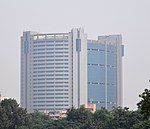Ramlila (Sanskrit: रामलीला, romanized: Rāmalīlā; literally 'Rama's lila or play') is any dramatic folk re-enactment of the life of Rama according to the ancient Hindu epic Ramayana or secondary literature based on it such as the Ramcharitmanas. It particularly refers to the thousands of the Hindu god Rama-related dramatic plays and dance events, that are staged during the annual autumn festival of Navaratri in India. After the enactment of the legendary war between good and evil, the Ramlila celebrations climax in the Vijayadashami (Dussehra) night festivities where the giant grotesque effigies of evil such as of the rakshasa (demon) Ravana are burnt, typically with fireworks.
Rama is the seventh avatar of the Hindu god Vishnu and the central figure of the Ramayana, a Sanskrit epic that integrates performance arts with stories driven by ethical values. The epic text is dated to the 1st millennium BCE and Ramlila is an adaptation of those stories. Most Ramlilas in North India are based on the 16th-century secondary work on Ramayana, Ramcharitmanas a verse form composition in the regional vernacular language (Awadhi a dialect of Hindi), by Tulsidas. These verses are used as dialogues in traditional adaptations. Open-air productions are staged by local Ramlila committees (Samitis), and funded entirely by the villagers or local neighbourhoods in urban areas. The core team of performance artists train for the dance-drama, but the actual performance attracts impromptu participants from the audience and villagers. This art form is a part of the Hindu culture, found for many gods and goddesses, but those of Rama, Durga (as Durga Puja) and Krishna (as Rasalila) are the most popular and annual events in the Indian subcontinent.The Ramlila festivities were declared by UNESCO as one of the "Intangible Cultural Heritage of Humanity" in 2008. Ramlila is particularly notable in historically important Hindu cities of Ayodhya, Varanasi, Vrindavan, Almora, Satna and Madhubani – cities in Uttar Pradesh, Uttarakhand, Bihar and Madhya Pradesh. The epic and its dramatic play migrated into Southeast Asia in the 1st millennium CE, and Ramayana based Ramlila is a part of performance art culture of Indonesia particularly the Hindu society of Bali, Myanmar, Cambodia and Thailand. In the 19th and 20th centuries, with the movement of the Indian diaspora into European colonies as indentured servants, the cultural celebration of Ramlila is now found in many parts of the world such as Mauritius, Africa, Fiji, Guyana, Malaysia, Singapore, South Africa, Suriname, and Trinidad and Tobago. It is also found in the United States, Canada, the United Kingdom, the Netherlands, Australia, and New Zealand.







